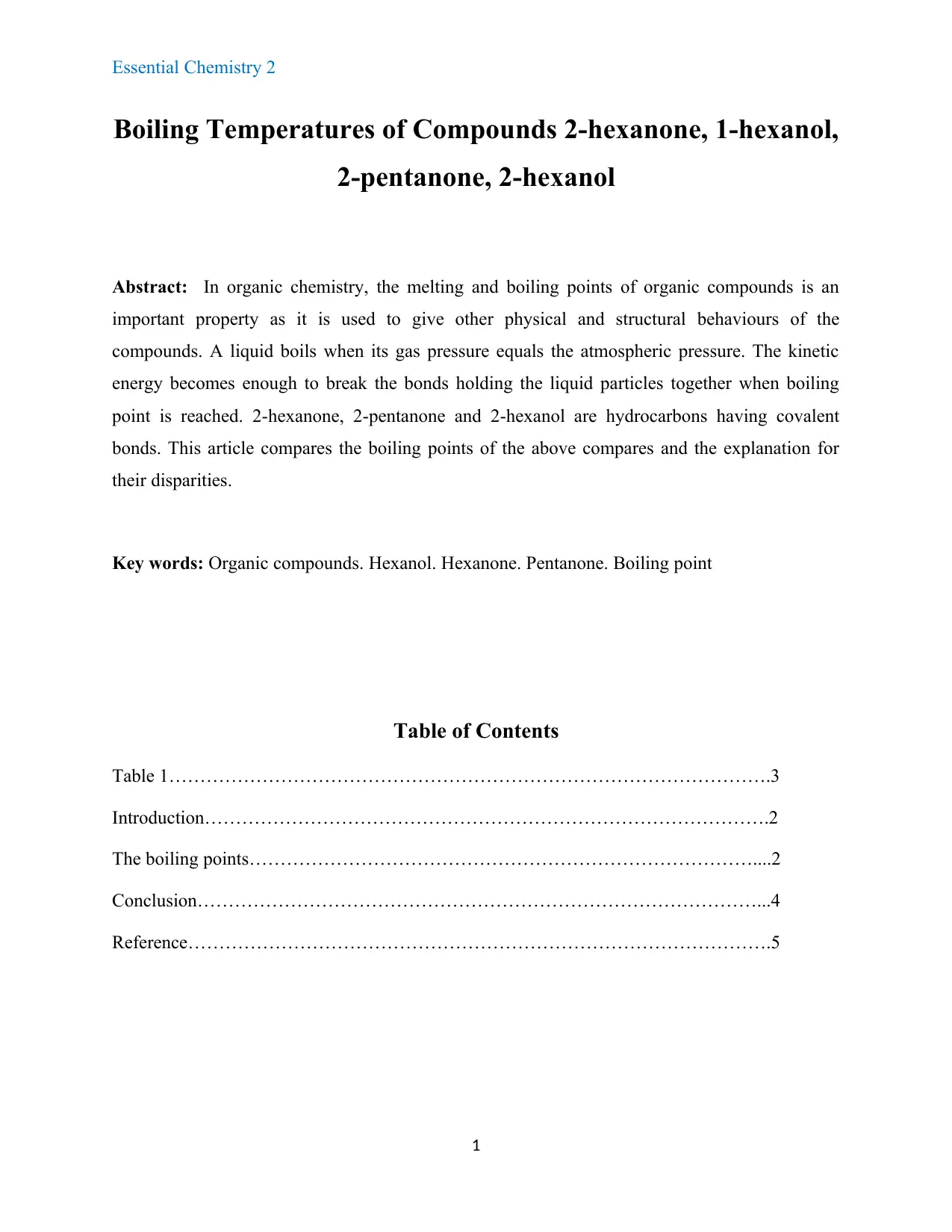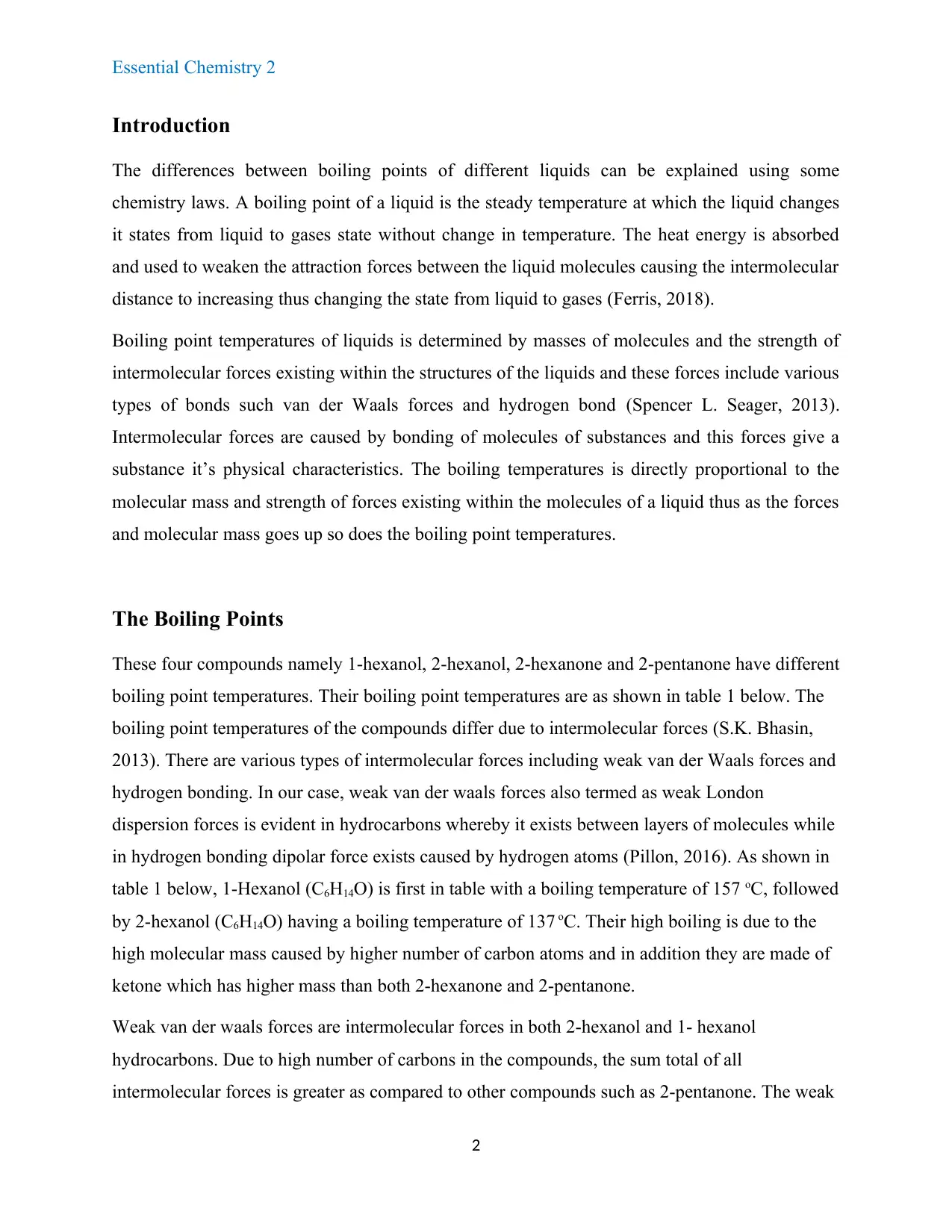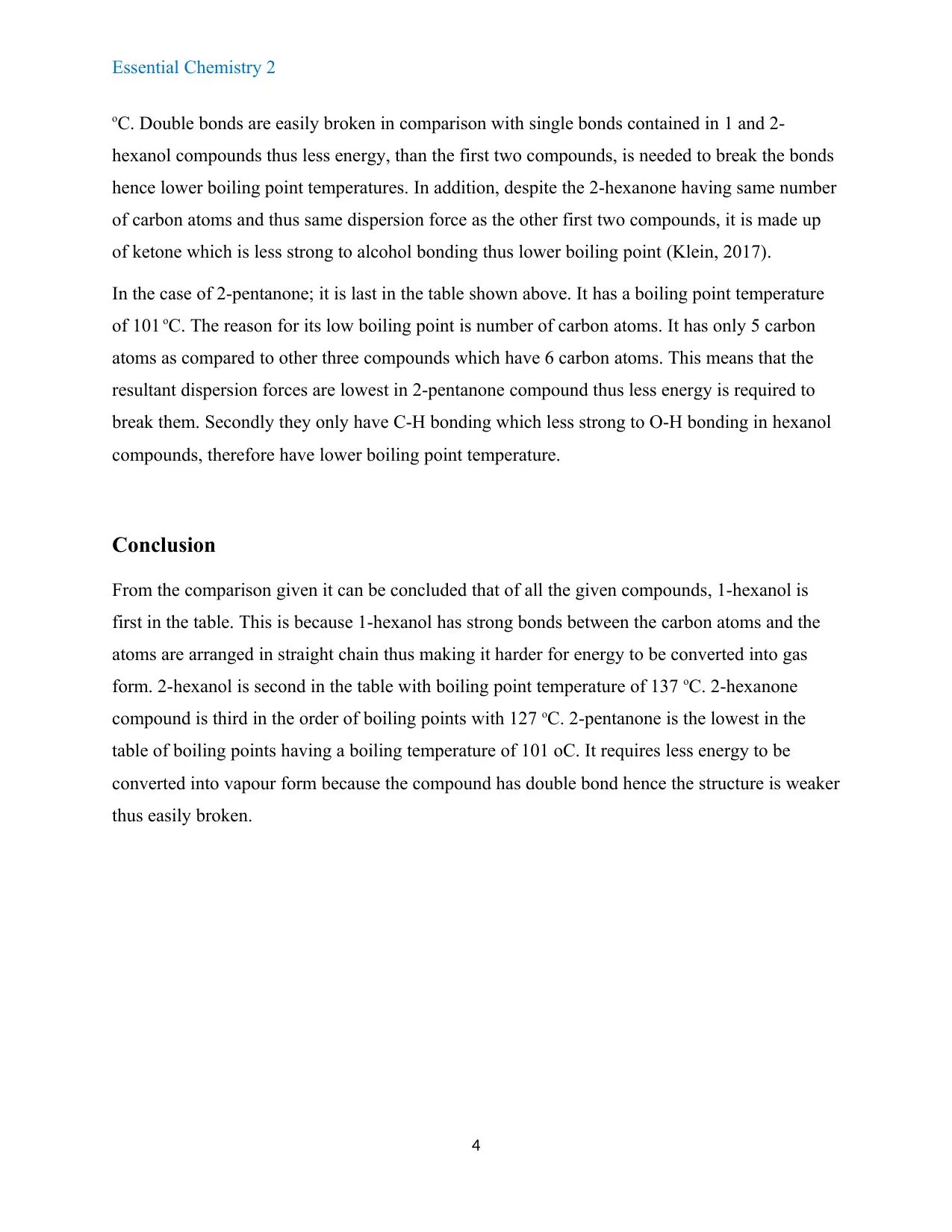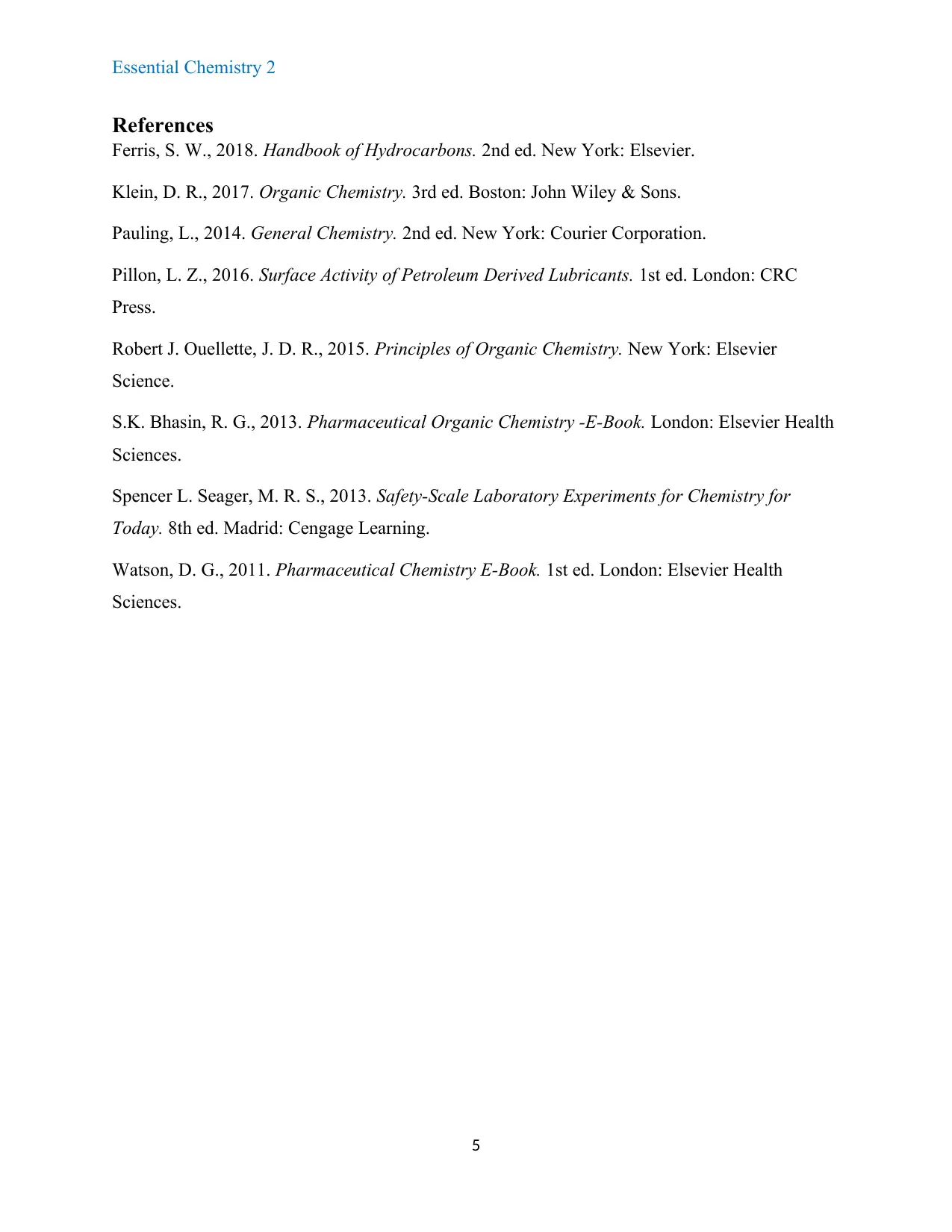Boiling Temperatures of Compounds 2-hexanone, 1-hexanol, 2-pentanone, 2-hexanol
VerifiedAdded on 2022/10/02
|5
|1371
|170
AI Summary
This article compares the boiling points of 2-hexanone, 1-hexanol, 2-pentanone, 2-hexanol and the explanation for their disparities. The boiling point temperatures of the compounds differ due to intermolecular forces. Read more on Desklib.
Contribute Materials
Your contribution can guide someone’s learning journey. Share your
documents today.

Essential Chemistry 2
Boiling Temperatures of Compounds 2-hexanone, 1-hexanol,
2-pentanone, 2-hexanol
Abstract: In organic chemistry, the melting and boiling points of organic compounds is an
important property as it is used to give other physical and structural behaviours of the
compounds. A liquid boils when its gas pressure equals the atmospheric pressure. The kinetic
energy becomes enough to break the bonds holding the liquid particles together when boiling
point is reached. 2-hexanone, 2-pentanone and 2-hexanol are hydrocarbons having covalent
bonds. This article compares the boiling points of the above compares and the explanation for
their disparities.
Key words: Organic compounds. Hexanol. Hexanone. Pentanone. Boiling point
Table of Contents
Table 1…………………………………………………………………………………….3
Introduction……………………………………………………………………………….2
The boiling points………………………………………………………………………....2
Conclusion………………………………………………………………………………...4
Reference………………………………………………………………………………….5
1
Boiling Temperatures of Compounds 2-hexanone, 1-hexanol,
2-pentanone, 2-hexanol
Abstract: In organic chemistry, the melting and boiling points of organic compounds is an
important property as it is used to give other physical and structural behaviours of the
compounds. A liquid boils when its gas pressure equals the atmospheric pressure. The kinetic
energy becomes enough to break the bonds holding the liquid particles together when boiling
point is reached. 2-hexanone, 2-pentanone and 2-hexanol are hydrocarbons having covalent
bonds. This article compares the boiling points of the above compares and the explanation for
their disparities.
Key words: Organic compounds. Hexanol. Hexanone. Pentanone. Boiling point
Table of Contents
Table 1…………………………………………………………………………………….3
Introduction……………………………………………………………………………….2
The boiling points………………………………………………………………………....2
Conclusion………………………………………………………………………………...4
Reference………………………………………………………………………………….5
1
Secure Best Marks with AI Grader
Need help grading? Try our AI Grader for instant feedback on your assignments.

Essential Chemistry 2
Introduction
The differences between boiling points of different liquids can be explained using some
chemistry laws. A boiling point of a liquid is the steady temperature at which the liquid changes
it states from liquid to gases state without change in temperature. The heat energy is absorbed
and used to weaken the attraction forces between the liquid molecules causing the intermolecular
distance to increasing thus changing the state from liquid to gases (Ferris, 2018).
Boiling point temperatures of liquids is determined by masses of molecules and the strength of
intermolecular forces existing within the structures of the liquids and these forces include various
types of bonds such van der Waals forces and hydrogen bond (Spencer L. Seager, 2013).
Intermolecular forces are caused by bonding of molecules of substances and this forces give a
substance it’s physical characteristics. The boiling temperatures is directly proportional to the
molecular mass and strength of forces existing within the molecules of a liquid thus as the forces
and molecular mass goes up so does the boiling point temperatures.
The Boiling Points
These four compounds namely 1-hexanol, 2-hexanol, 2-hexanone and 2-pentanone have different
boiling point temperatures. Their boiling point temperatures are as shown in table 1 below. The
boiling point temperatures of the compounds differ due to intermolecular forces (S.K. Bhasin,
2013). There are various types of intermolecular forces including weak van der Waals forces and
hydrogen bonding. In our case, weak van der waals forces also termed as weak London
dispersion forces is evident in hydrocarbons whereby it exists between layers of molecules while
in hydrogen bonding dipolar force exists caused by hydrogen atoms (Pillon, 2016). As shown in
table 1 below, 1-Hexanol (C6H14O) is first in table with a boiling temperature of 157 oC, followed
by 2-hexanol (C6H14O) having a boiling temperature of 137 oC. Their high boiling is due to the
high molecular mass caused by higher number of carbon atoms and in addition they are made of
ketone which has higher mass than both 2-hexanone and 2-pentanone.
Weak van der waals forces are intermolecular forces in both 2-hexanol and 1- hexanol
hydrocarbons. Due to high number of carbons in the compounds, the sum total of all
intermolecular forces is greater as compared to other compounds such as 2-pentanone. The weak
2
Introduction
The differences between boiling points of different liquids can be explained using some
chemistry laws. A boiling point of a liquid is the steady temperature at which the liquid changes
it states from liquid to gases state without change in temperature. The heat energy is absorbed
and used to weaken the attraction forces between the liquid molecules causing the intermolecular
distance to increasing thus changing the state from liquid to gases (Ferris, 2018).
Boiling point temperatures of liquids is determined by masses of molecules and the strength of
intermolecular forces existing within the structures of the liquids and these forces include various
types of bonds such van der Waals forces and hydrogen bond (Spencer L. Seager, 2013).
Intermolecular forces are caused by bonding of molecules of substances and this forces give a
substance it’s physical characteristics. The boiling temperatures is directly proportional to the
molecular mass and strength of forces existing within the molecules of a liquid thus as the forces
and molecular mass goes up so does the boiling point temperatures.
The Boiling Points
These four compounds namely 1-hexanol, 2-hexanol, 2-hexanone and 2-pentanone have different
boiling point temperatures. Their boiling point temperatures are as shown in table 1 below. The
boiling point temperatures of the compounds differ due to intermolecular forces (S.K. Bhasin,
2013). There are various types of intermolecular forces including weak van der Waals forces and
hydrogen bonding. In our case, weak van der waals forces also termed as weak London
dispersion forces is evident in hydrocarbons whereby it exists between layers of molecules while
in hydrogen bonding dipolar force exists caused by hydrogen atoms (Pillon, 2016). As shown in
table 1 below, 1-Hexanol (C6H14O) is first in table with a boiling temperature of 157 oC, followed
by 2-hexanol (C6H14O) having a boiling temperature of 137 oC. Their high boiling is due to the
high molecular mass caused by higher number of carbon atoms and in addition they are made of
ketone which has higher mass than both 2-hexanone and 2-pentanone.
Weak van der waals forces are intermolecular forces in both 2-hexanol and 1- hexanol
hydrocarbons. Due to high number of carbons in the compounds, the sum total of all
intermolecular forces is greater as compared to other compounds such as 2-pentanone. The weak
2

Essential Chemistry 2
van der forces are forces of attraction that comes up when electrons in consecutive atoms are in
positions which renders the atoms to behave like dipoles. The table 1 below shows the boiling
point temperatures, functional group and molecular structures of the four compounds.
Compound B.P temperatures
(oC)
Functional
Group
Molecular Structures
1-hexanol
(C6H14O)
157 oC Alcohol
2-hexanol
(C6H14O)
137 oC Alcohol
2-hexanone
(C6H12O)
127 oC Ketone
2-pentanone
(C5H10O)
101 oC Ketone
Table1: the boiling points and some structural properties of the compounds (Watson, 2011)
As shown in the table 1 above, 1-Hexanol and 2-Hexanol are alcohols. These alcohols contain
hydroxyl functional group which is known to have strong intermolecular bonding by hydrogen
bond. The strong bonds in the two compounds, thus, need a lot of energy to be broken and state
changed to gaseous form. This explains their high boiling point temperatures. In addition, 1 and
2-hexanol compounds have stronger hydrogen bond as compared to 2-pentanone and 2-
hexanone. This is because they have an O-H bond. It is well known that molecules having
hydrogen-oxygen are stronger than those having carbon-hydrogen bonds thus the former have
high boiling points (Robert J. Ouellette, 2015). The O-H molecules, therefore, need more energy
to be broken as compared to C-H molecules. Also, hydrocarbons have high melting and boiling
points and the B.P and M.P increase with increase in the number carbon atoms in the atomic
lattice. This is because increase in number of carbons leads to increase in sum total of weak
dispersion forces which in turn increases the boiling point temperatures of the liquid (Pauling,
2014).
Hydrocarbon 2-hexanone is third in order of boiling point temperatures. 2-hexanone has ketone
as a functional group and ketone is bonded by double bonds. Its boiling point temperature is 127
3
van der forces are forces of attraction that comes up when electrons in consecutive atoms are in
positions which renders the atoms to behave like dipoles. The table 1 below shows the boiling
point temperatures, functional group and molecular structures of the four compounds.
Compound B.P temperatures
(oC)
Functional
Group
Molecular Structures
1-hexanol
(C6H14O)
157 oC Alcohol
2-hexanol
(C6H14O)
137 oC Alcohol
2-hexanone
(C6H12O)
127 oC Ketone
2-pentanone
(C5H10O)
101 oC Ketone
Table1: the boiling points and some structural properties of the compounds (Watson, 2011)
As shown in the table 1 above, 1-Hexanol and 2-Hexanol are alcohols. These alcohols contain
hydroxyl functional group which is known to have strong intermolecular bonding by hydrogen
bond. The strong bonds in the two compounds, thus, need a lot of energy to be broken and state
changed to gaseous form. This explains their high boiling point temperatures. In addition, 1 and
2-hexanol compounds have stronger hydrogen bond as compared to 2-pentanone and 2-
hexanone. This is because they have an O-H bond. It is well known that molecules having
hydrogen-oxygen are stronger than those having carbon-hydrogen bonds thus the former have
high boiling points (Robert J. Ouellette, 2015). The O-H molecules, therefore, need more energy
to be broken as compared to C-H molecules. Also, hydrocarbons have high melting and boiling
points and the B.P and M.P increase with increase in the number carbon atoms in the atomic
lattice. This is because increase in number of carbons leads to increase in sum total of weak
dispersion forces which in turn increases the boiling point temperatures of the liquid (Pauling,
2014).
Hydrocarbon 2-hexanone is third in order of boiling point temperatures. 2-hexanone has ketone
as a functional group and ketone is bonded by double bonds. Its boiling point temperature is 127
3

Essential Chemistry 2
oC. Double bonds are easily broken in comparison with single bonds contained in 1 and 2-
hexanol compounds thus less energy, than the first two compounds, is needed to break the bonds
hence lower boiling point temperatures. In addition, despite the 2-hexanone having same number
of carbon atoms and thus same dispersion force as the other first two compounds, it is made up
of ketone which is less strong to alcohol bonding thus lower boiling point (Klein, 2017).
In the case of 2-pentanone; it is last in the table shown above. It has a boiling point temperature
of 101 oC. The reason for its low boiling point is number of carbon atoms. It has only 5 carbon
atoms as compared to other three compounds which have 6 carbon atoms. This means that the
resultant dispersion forces are lowest in 2-pentanone compound thus less energy is required to
break them. Secondly they only have C-H bonding which less strong to O-H bonding in hexanol
compounds, therefore have lower boiling point temperature.
Conclusion
From the comparison given it can be concluded that of all the given compounds, 1-hexanol is
first in the table. This is because 1-hexanol has strong bonds between the carbon atoms and the
atoms are arranged in straight chain thus making it harder for energy to be converted into gas
form. 2-hexanol is second in the table with boiling point temperature of 137 oC. 2-hexanone
compound is third in the order of boiling points with 127 oC. 2-pentanone is the lowest in the
table of boiling points having a boiling temperature of 101 oC. It requires less energy to be
converted into vapour form because the compound has double bond hence the structure is weaker
thus easily broken.
4
oC. Double bonds are easily broken in comparison with single bonds contained in 1 and 2-
hexanol compounds thus less energy, than the first two compounds, is needed to break the bonds
hence lower boiling point temperatures. In addition, despite the 2-hexanone having same number
of carbon atoms and thus same dispersion force as the other first two compounds, it is made up
of ketone which is less strong to alcohol bonding thus lower boiling point (Klein, 2017).
In the case of 2-pentanone; it is last in the table shown above. It has a boiling point temperature
of 101 oC. The reason for its low boiling point is number of carbon atoms. It has only 5 carbon
atoms as compared to other three compounds which have 6 carbon atoms. This means that the
resultant dispersion forces are lowest in 2-pentanone compound thus less energy is required to
break them. Secondly they only have C-H bonding which less strong to O-H bonding in hexanol
compounds, therefore have lower boiling point temperature.
Conclusion
From the comparison given it can be concluded that of all the given compounds, 1-hexanol is
first in the table. This is because 1-hexanol has strong bonds between the carbon atoms and the
atoms are arranged in straight chain thus making it harder for energy to be converted into gas
form. 2-hexanol is second in the table with boiling point temperature of 137 oC. 2-hexanone
compound is third in the order of boiling points with 127 oC. 2-pentanone is the lowest in the
table of boiling points having a boiling temperature of 101 oC. It requires less energy to be
converted into vapour form because the compound has double bond hence the structure is weaker
thus easily broken.
4
Secure Best Marks with AI Grader
Need help grading? Try our AI Grader for instant feedback on your assignments.

Essential Chemistry 2
References
Ferris, S. W., 2018. Handbook of Hydrocarbons. 2nd ed. New York: Elsevier.
Klein, D. R., 2017. Organic Chemistry. 3rd ed. Boston: John Wiley & Sons.
Pauling, L., 2014. General Chemistry. 2nd ed. New York: Courier Corporation.
Pillon, L. Z., 2016. Surface Activity of Petroleum Derived Lubricants. 1st ed. London: CRC
Press.
Robert J. Ouellette, J. D. R., 2015. Principles of Organic Chemistry. New York: Elsevier
Science.
S.K. Bhasin, R. G., 2013. Pharmaceutical Organic Chemistry -E-Book. London: Elsevier Health
Sciences.
Spencer L. Seager, M. R. S., 2013. Safety-Scale Laboratory Experiments for Chemistry for
Today. 8th ed. Madrid: Cengage Learning.
Watson, D. G., 2011. Pharmaceutical Chemistry E-Book. 1st ed. London: Elsevier Health
Sciences.
5
References
Ferris, S. W., 2018. Handbook of Hydrocarbons. 2nd ed. New York: Elsevier.
Klein, D. R., 2017. Organic Chemistry. 3rd ed. Boston: John Wiley & Sons.
Pauling, L., 2014. General Chemistry. 2nd ed. New York: Courier Corporation.
Pillon, L. Z., 2016. Surface Activity of Petroleum Derived Lubricants. 1st ed. London: CRC
Press.
Robert J. Ouellette, J. D. R., 2015. Principles of Organic Chemistry. New York: Elsevier
Science.
S.K. Bhasin, R. G., 2013. Pharmaceutical Organic Chemistry -E-Book. London: Elsevier Health
Sciences.
Spencer L. Seager, M. R. S., 2013. Safety-Scale Laboratory Experiments for Chemistry for
Today. 8th ed. Madrid: Cengage Learning.
Watson, D. G., 2011. Pharmaceutical Chemistry E-Book. 1st ed. London: Elsevier Health
Sciences.
5
1 out of 5
Related Documents
Your All-in-One AI-Powered Toolkit for Academic Success.
+13062052269
info@desklib.com
Available 24*7 on WhatsApp / Email
![[object Object]](/_next/static/media/star-bottom.7253800d.svg)
Unlock your academic potential
© 2024 | Zucol Services PVT LTD | All rights reserved.





